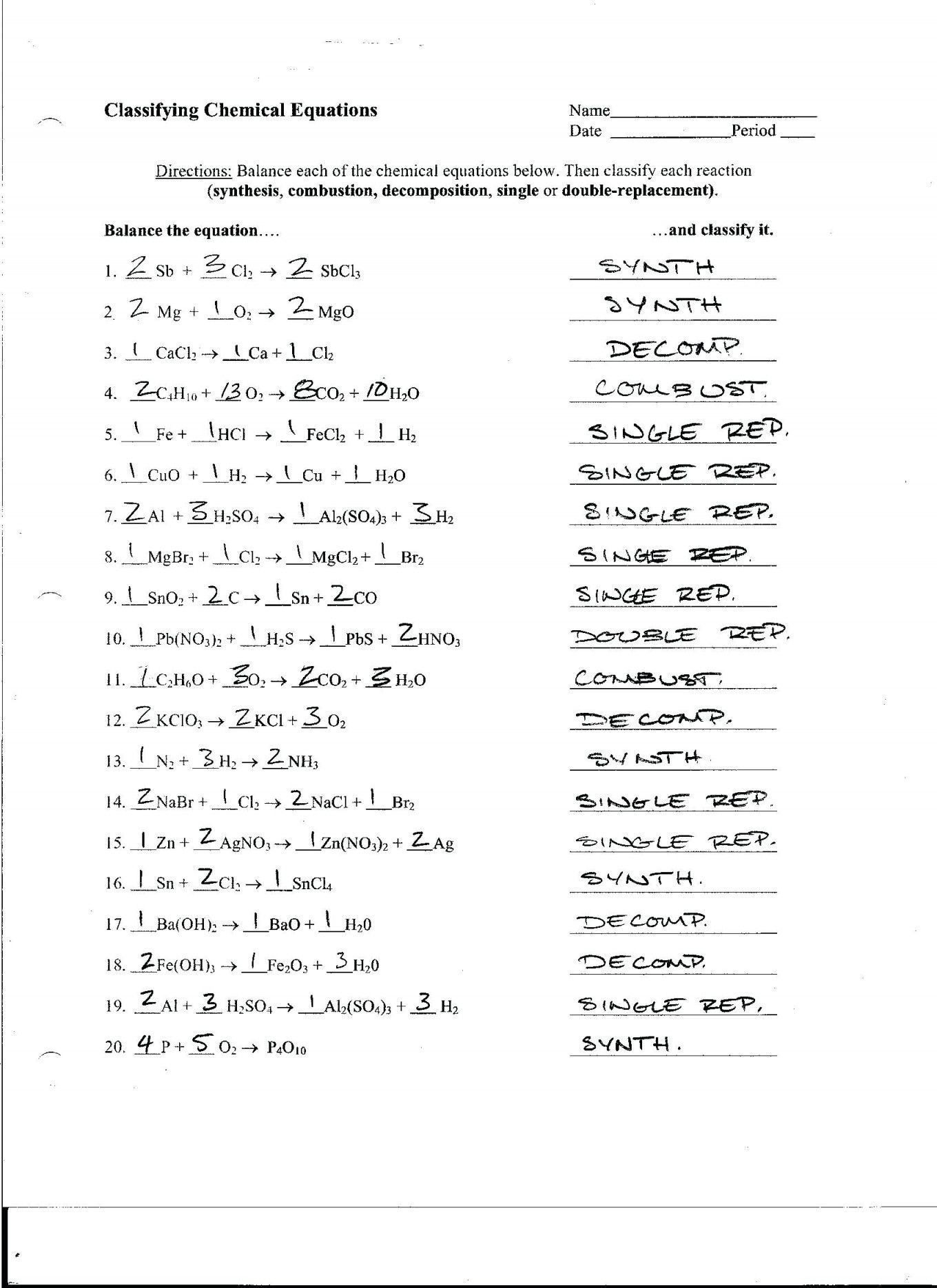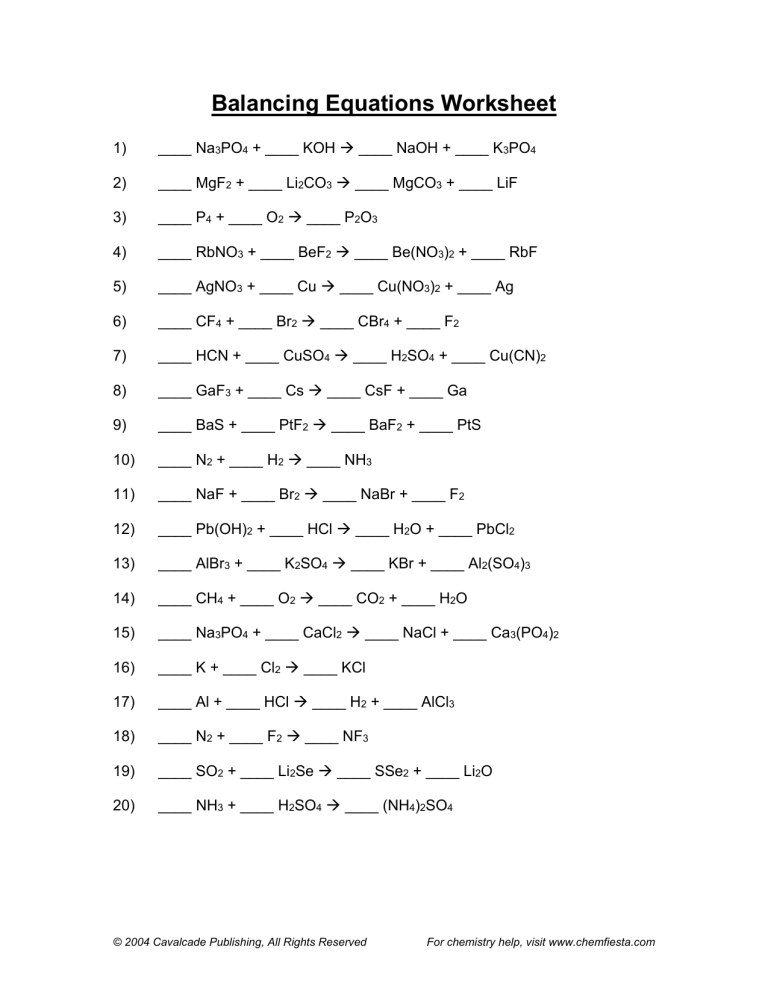Remember that thrilling moment in chemistry class when the teacher introduced the concept of chemical reactions, and you were eager to learn how to represent these fascinating transformations using equations? But then came the daunting task of classifying and balancing these equations, a hurdle that often left us scratching our heads and seeking answers. While classifying and balancing equations might seem like a simple task at first glance, understanding the underlying principles and developing proficiency in this skill is crucial for grasping the fundamentals of chemistry.

Image: learningdbunbunged.z21.web.core.windows.net
This article will serve as your comprehensive guide to conquering the world of classifying and balancing equations. From understanding the basics to mastering the techniques, we’ll delve into the intricacies of this topic and equip you with the knowledge and tools you need to confidently tackle any equation you encounter. Get ready for an exciting journey as we explore the fascinating world of chemical reactions and unlock the answers to those pesky practice problems.
Understanding Chemical Equations: The Language of Chemistry
At its core, a chemical equation is a symbolic representation of a chemical reaction, depicting the rearrangement of atoms and molecules that occurs during the process. It provides valuable information about the reactants, the substances that are consumed in the reaction, and the products, the newly formed substances.
Imagine a chemical equation like a recipe, where the ingredients are the reactants, and the dish you’re preparing is the product. For instance, the equation for the reaction of hydrogen and oxygen to form water can be written as: 2H2 + O2 → 2H2O. This equation tells us that two molecules of hydrogen (H2) react with one molecule of oxygen (O2) to produce two molecules of water (H2O).
Classifying Chemical Reactions: Categorizing Transformations
Chemical reactions occur in diverse ways, ranging from simple combinations to complex rearrangements of atoms. To make sense of this vast array of reactions, chemists have developed a system for classifying them into different categories based on the changes that occur during the reaction. This classification system helps us predict the products, understand the energy changes involved, and ultimately grasp the fundamental principles behind these transformations.
Here are some common types of chemical reactions:
Types of Chemical Reactions
- Synthesis Reactions: These reactions involve the combination of two or more reactants to form a single product. A simple example is the reaction of sodium and chlorine to form sodium chloride (table salt): 2Na + Cl2 → 2NaCl.
- Decomposition Reactions: These reactions are the opposite of synthesis reactions, where a single reactant breaks down into two or more products. A common example is the decomposition of hydrogen peroxide (H2O2) into water (H2O) and oxygen (O2): 2H2O2 → 2H2O + O2.
- Single Replacement Reactions: In these reactions, one element replaces another in a compound. A classic example is the reaction of zinc with hydrochloric acid (HCl) to form zinc chloride (ZnCl2) and hydrogen gas (H2): Zn + 2HCl → ZnCl2 + H2.
- Double Replacement Reactions: As the name suggests, these reactions involve the exchange of ions between two reactants, resulting in the formation of two new compounds. For instance, the reaction of silver nitrate (AgNO3) with sodium chloride (NaCl) to form silver chloride (AgCl) and sodium nitrate (NaNO3): AgNO3 + NaCl → AgCl + NaNO3.
- Combustion Reactions: These reactions involve the rapid reaction between a substance with an oxidant, usually oxygen, producing heat and light. A familiar example is the burning of fuel like wood or propane: C3H8 + 5O2 → 3CO2 + 4H2O .

Image: studylib.net
Balancing Chemical Equations: The Law of Conservation of Mass
The concept of balancing chemical equations is rooted in the fundamental law of conservation of mass, which states that in an isolated system, the total mass of the reactants before a chemical reaction must equal the total mass of the products after the reaction. This means that atoms are neither created nor destroyed during a chemical reaction; they are simply rearranged.
To demonstrate this principle, consider the combustion of methane (CH4) in the presence of oxygen (O2) to produce carbon dioxide (CO2) and water (H2O): CH4 + O2 → CO2 + H2O. Initially, the equation appears to be unbalanced as the number of atoms of each element on the reactant side doesn’t match the number on the product side.
To balance this equation, we need to adjust the coefficients in front of each chemical formula. Remember, coefficients are the numbers that multiply the entire chemical formula. By adjusting the coefficients, we can ensure that the number of atoms of each element is the same on both sides of the equation. Applying this principle, we get the balanced equation: CH4 + 2O2 → CO2 + 2H2O.
Tips and Expert Advice for Master Balancing Chemical Equations
Balancing chemical equations might seem challenging initially, but with a systematic approach and a little practice, you can master this skill. Here are some tips to help you navigate this process effortlessly:
- Start with the most complex molecule: Begin by balancing the molecule with the most atoms or the most complex structure. This strategy often simplifies the process as you can then adjust the coefficients of other molecules accordingly.
- Balance elements one at a time: Focus on balancing one element at a time, working your way through the equation systematically. This approach reduces the likelihood of getting lost in complex equations.
- Use fractions if necessary: Don’t hesitate to use fractions as coefficients if needed to balance the equation, especially when dealing with elements that appear in odd numbers. You can always multiply the entire equation by a common denominator to convert the fractions into whole numbers.
- Practice makes perfect: The key to mastering balancing equations is practice. Work through numerous examples, gradually increasing the complexity, and soon you’ll find yourself confidently balancing even the most intricate chemical equations.
FAQ: Clearing Up Common Questions
Q: Why is it important to balance chemical equations?
A: Balancing chemical equations is essential because it ensures that the law of conservation of mass is upheld. By balancing the equation, we maintain the equality of atoms on both sides of the reaction, reflecting the fundamental principle that atoms are neither created nor destroyed during a chemical reaction.
Q: What if I’m unable to balance a chemical equation?
A: Don’t get discouraged if you struggle to balance an equation right away. Check your work carefully, ensuring that you’re adjusting only the coefficients and not changing the chemical formulas. If you’re still facing difficulties, try breaking down the equation into smaller steps, balancing one element at a time. You can also refer to online resources or textbooks for step-by-step guidance.
Q: What are some common mistakes to avoid when balancing equations?
A: It’s easy to fall into common pitfalls when balancing equations. Avoid changing the subscript numbers within the chemical formula, as this alters the chemical composition of the substance. Also, ensure that you’re balancing the number of atoms of each element, not just comparing the number of molecules on each side.
Classifying And Balancing Equations Worksheet Answers
Conclusion: Embracing the Power of Chemical Equations
Mastering the ability to classify and balance chemical equations opens doors to a deeper understanding of the dynamic world of chemistry. These fundamental skills are essential for predicting chemical reactions, designing experiments, and deciphering the language of the natural world.
As you delve deeper into the fascinating realm of chemistry, remember that classifying and balancing equations are not just exercises but powerful tools that empower you to unravel the secrets of the universe. So, embrace the challenge, practice diligently, and confidently navigate the world of chemical reactions!
Are you ready to take your understanding of chemical reactions to the next level?





